Web Programming Step by Step
Chapter 8
The Document Object Model (DOM)
Except where otherwise noted, the contents of this presentation are Copyright 2009 Marty Stepp and Jessica Miller.
8.1: Global DOM Objects
- 8.1: Global DOM Objects
- 8.2: DOM Element Objects
- 8.3: The DOM Tree
The six global DOM objects
Every Javascript program can refer to the following global objects:
| name | description |
|---|---|
document
|
current HTML page and its content |
history
|
list of pages the user has visited |
location
|
URL of the current HTML page |
navigator
|
info about the web browser you are using |
screen
|
info about the screen area occupied by the browser |
window
|
the browser window |
The window object
the entire browser window; the top-level object in DOM hierarchy
- technically, all global code and variables become part of the
windowobject - properties:
- methods:
-
alert,confirm,prompt(popup boxes) -
setInterval,setTimeoutclearInterval,clearTimeout(timers) -
open,close(popping up new browser windows) -
blur,focus,moveBy,moveTo,print,resizeBy,resizeTo,scrollBy,scrollTo
-
The document object
the current web page and the elements inside it
- properties:
- methods:
- complete list
The location object
the URL of the current web page
The navigator object
information about the web browser application
- properties:
-
Some web programmers examine the
navigatorobject to see what browser is being used, and write browser-specific scripts and hacks:if (navigator.appName === "Microsoft Internet Explorer") { ...- (this is poor style; you should not need to do this)
The history object
the list of sites the browser has visited in this window
- properties:
- methods:
- complete list
- sometimes the browser won't let scripts view
historyproperties, for security
Unobtrusive JavaScript (8.1.1)
- JavaScript event code seen previously was obtrusive, in the HTML; this is bad style
- now we'll see how to write unobtrusive JavaScript code
- HTML with minimal JavaScript inside
- uses the DOM to attach and execute all JavaScript functions
- allows separation of web site into 3 major categories:
- content (HTML) - what is it?
- presentation (CSS) - how does it look?
- behavior (JavaScript) - how does it respond to user interaction?
Obtrusive event handlers (bad)
<button id="ok" onclick="okayClick();">OK</button>
// called when OK button is clicked
function okayClick() {
alert("booyah");
}
- this is bad style (HTML is cluttered with JS code)
- goal: remove all JavaScript code from page's body
Attaching an event handler in JavaScript code
// where element is a DOM element object
element.event = function;
var okButton = document.getElementById("ok");
okButton.onclick = okayClick;
- it is legal to attach event handlers to elements' DOM objects in your JavaScript code
- this is better style than attaching them in the XHTML
- Where should we put the above code?
A failed attempt at being unobtrusive
<head> <script src="myfile.js" type="text/javascript"></script> </head> <body> <div><button id="ok">OK</button></div>
// global code var okButton = document.getElementById("ok"); okButton.onclick = okayClick; // error: okButton is undefined
- problem: global JS code runs the moment the script is loaded
- script in
headis processed before page'sbodyhas loaded- no elements are available yet or can be accessed yet via the DOM
- we need a way to attach the handler just as the page finishes loading
The window.onload event
(8.1.1)
window.onload = functionName; // global code
// this will run once the page has finished loading
function functionName() {
element.event = functionName;
element.event = functionName;
...
}
- we want to attach our event handlers right after the page is done loading
- there is a global event called
window.onloadevent that occurs at that moment - in
window.onloadhandler we attach all the other handlers to run when events occur
An unobtrusive event handler
<!-- look Ma, no JavaScript! -->
<button id="ok">OK</button>
window.onload = pageLoad; // global code // called when page loads; sets up event handlers function pageLoad() { var okButton = document.getElementById("ok"); okButton.onclick = okayClick; } function okayClick() { alert("booyah"); }
Common unobtrusive JS errors
- many students mistakenly write
()when attaching the handlerwindow.onload = pageLoad();window.onload = pageLoad;okButton.onclick = okayClick();okButton.onclick = okayClick;- our JSLint checker will catch this mistake
- event names are all lowercase, not capitalized like most variables
window.onLoad = pageLoad;window.onload = pageLoad;
Anonymous functions (8.1.2)
function(parameters) {
statements;
}
- JavaScript allows you to declare anonymous functions
- quickly creates a function without giving it a name
- can be stored as a variable, attached as an event handler, etc.
Anonymous function example
window.onload = function() {
var okButton = document.getElementById("ok");
okButton.onclick = okayClick;
};
function okayClick() {
alert("booyah");
}
or the following is also legal (though harder to read and bad style):
window.onload = function() {
var okButton = document.getElementById("ok");
okButton.onclick = function() {
alert("booyah");
};
};
The keyword this
(8.1.3)
window.onload = pageLoad;
function pageLoad() {
var okButton = document.getElementById("ok");
okButton.onclick = okayClick; // bound to okButton here
}
function okayClick() { // okayClick knows what DOM object
this.innerHTML = "booyah"; // it was called on
}
- event handlers attached unobtrusively are bound to the element
- inside the handler, the element can refer to itself as
this- also useful when the same handler is shared on multiple elements
Fixing redundant code with this
<fieldset> <label><input id="Huey" type="radio" name="ducks" /> Huey</label> <label><input id="Dewey" type="radio" name="ducks" /> Dewey</label> <label><input id="Louie" type="radio" name="ducks" /> Louie</label> </fieldset>
function processDucks() {
if (document.getElementById("huey").checked) {
alert("Huey is checked!");
} else if (document.getElementById("dewey").checked) {
alert("Dewey is checked!");
} else {
alert("Louie is checked!");
}
alert(this.id + " is checked!");
}
8.2: DOM Element Objects
- 8.1: Global DOM Objects
- 8.2: DOM Element Objects
- 8.3: The DOM Tree
Modifying text inside an element
var paragraph = document.getElementById("welcome");
paragraph.innerHTML = "Welcome to our site!"; // change text on page
DOM element objects have the following properties:
innerHTML: text and/or HTML tags inside a nodetextContent: text (no HTML tags) inside a node-
simpler than
innerHTML, but not supported in IE6
-
simpler than
value: the value inside a form control
Abuse of innerHTML
// bad style!
var paragraph = document.getElementById("welcome");
paragraph.innerHTML = "<p>text and <a href="page.html">link</a>";
innerHTMLcan inject arbitrary HTML content into the page- however, this is prone to bugs and errors and is considered poor style
- we forbid using
innerHTMLto inject HTML tags; inject plain text only- so how do we add content with HTML tags in it to the page?
Adjusting styles with the DOM (8.2.2)
<button id="clickme">Color Me</button>
window.onload = function() {
document.getElementById("clickme").onclick = changeColor;
};
function changeColor() {
var clickMe = document.getElementById("clickme");
clickMe.style.color = "red";
}
styleproperty lets you set any CSS style for an element- contains same properties as in CSS, but with
camelCasedNames- examples:
backgroundColor,borderLeftWidth,fontFamily
- examples:
Common DOM styling errors
- many students forget to write
.stylewhen setting stylesvar clickMe = document.getElementById("clickme");clickMe.color = "red";clickMe.style.color = "red"; - style properties are capitalized
likeThis, notlike-thisclickMe.style.font-size = "14pt";clickMe.style.fontSize = "14pt"; - style properties must be set as strings, often with units at the end
clickMe.style.width = 200;clickMe.style.width = "200px"; clickMe.style.padding = "0.5em";- write the value you would have written in the CSS, but in quotes
Unobtrusive styling (8.2.3)
function okayClick() {
this.style.color = "red";
this.className = "highlighted";
}
.highlighted { color: red; }
- well-written JavaScript code should contain as little CSS as possible
- use JS to set CSS classes/IDs on elements
- define the styles of those classes/IDs in your CSS file
8.3: The DOM Tree
- 8.1: Global DOM Objects
- 8.2: DOM Element Objects
- 8.3: The DOM Tree
Complex DOM manipulation problems
How would we do each of the following in JavaScript code? Each involves modifying each one of a group of elements ...
- When the Go button is clicked, reposition all the
divs of classpuzzleto random x/y locations. - When the user hovers over the maze boundary, turn all maze walls red.
- Change every other item in the
ullist withidofTAsto have a gray background.
The tree of DOM objects
-
The elements of a page are nested into a tree-like structure of objects
- the DOM has properties and methods for traversing this tree
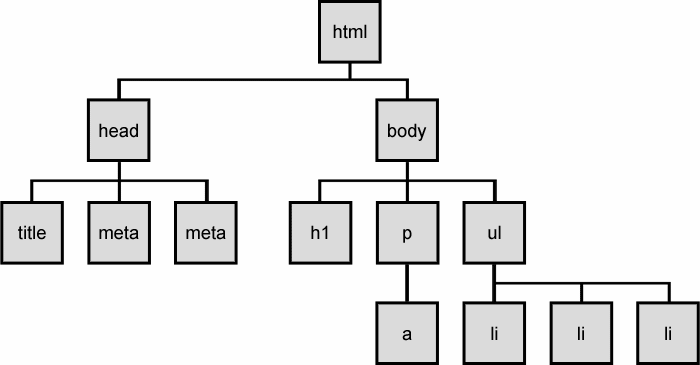
Types of DOM nodes (8.3.1)
<p> This is a paragraph of text with a <a href="/path/to/another/page.html">link</a>. </p>
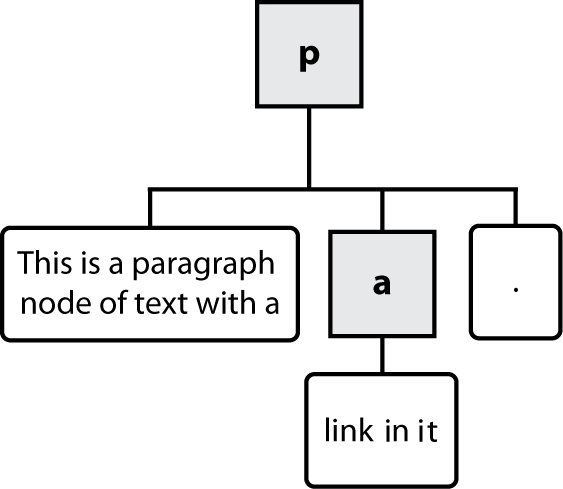
 element nodes (HTML tag)
element nodes (HTML tag)
- can have children and/or attributes
 text nodes (text in a block element)
text nodes (text in a block element)
 attribute nodes (attribute/value pair)
attribute nodes (attribute/value pair)
- text/attributes are children in an element node
- they cannot have children or attributes
Traversing the DOM tree (8.3.2 - 8.3.3)
every node's DOM object has the following properties:
| name(s) | description |
|---|---|
firstChild, lastChild
|
start/end of this node's list of children |
childNodes
|
array of all this node's children |
nextSibling, previousSibling
|
neighboring nodes with the same parent |
parentNode
|
the element that contains this node |
DOM tree traversal example
<p id="foo">This is a paragraph of text with a <a href="/path/to/another/page.html">link</a>.</p>
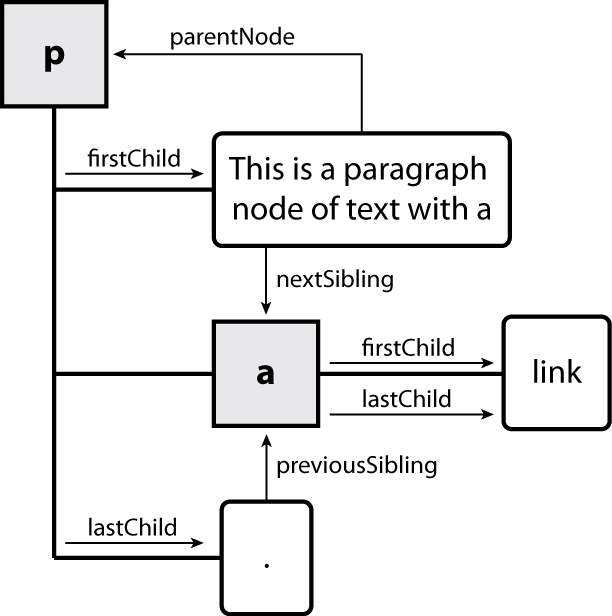
Element vs. text nodes
<div> <p> This is a paragraph of text with a <a href="page.html">link</a>. </p> </div>
- Q: How many children does the
divabove have? - A: 3
- an element node representing the <p>
- two text nodes representing
"\n\t"(before/after the paragraph)
-
Q: How many children does the paragraph have? The
atag?
Selecting groups of DOM objects (8.3.5)
-
methods in
documentand other DOM objects for accessing descendents:
| name | description |
|---|---|
getElementsByTagName
|
returns array of descendents that have the given HTML tag, such as "div"
|
getElementsByName
|
returns array of descendents that have the given name attribute (mostly useful for accessing form controls)
|
Getting all elements of a certain type
highlight all paragraphs in the document:
var allParas = document.getElementsByTagName("p");
for (var i = 0; i < allParas.length; i++) {
allParas[i].style.backgroundColor = "yellow";
}
<body> <p>This is the first paragraph</p> <p>This is the second paragraph</p> <p>You get the idea...</p> </body>
Combining with getElementById
highlight all paragraphs inside of the section with ID "address":
var addr = document.getElementById("address");
var addrParas = addr.getElementsByTagName("p");
for (var i = 0; i < addrParas.length; i++) {
addrParas[i].style.backgroundColor = "yellow";
}
<p>This won't be returned!</p>
<div id="address">
<p>1234 Street</p>
<p>Atlanta, GA</p>
</div>Creating new nodes (8.3.5)
// create a new <h2> node
var newHeading = document.createElement("h2");
newHeading.innerHTML = "This is a heading";
newHeading.style.color = "green";
-
document.createElement("tag"): creates and returns a new empty DOM node representing an element of that type- this node's properties can be set just like any other DOM node's
-
document.createTextNode("text"): creates and returns a new text node containing the given text
Modifying the DOM tree
Every DOM element object has these methods:
| name | description |
|---|---|
appendChild(node)
|
places given node at end of this node's child list |
insertBefore(new, old)
|
places the given new node in this node's child list just before old child
|
removeChild(node)
|
removes given node from this node's child list |
replaceChild(new, old)
|
replaces given child with new node |
Adding a node to the page
window.onload = function() {
var thisSlide = document.getElementById("slide38");
thisSlide.onclick = slideClick;
}
function slideClick() {
var p = document.createElement("p");
p.innerHTML = "A paragraph!";
this.appendChild(p);
}
- merely creating a node does not add it to the page
- you must add the new node as a child of an existing element on the page
Firebug's debugger
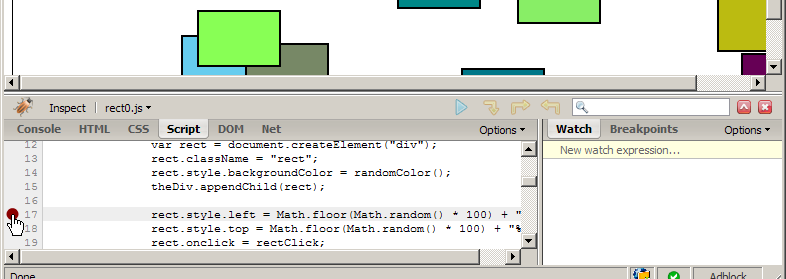
- open Firebug, click Script tab
- click to the left of a line to set a breakpoint
- refresh page; when script gets to that line, program will halt
Breakpoints
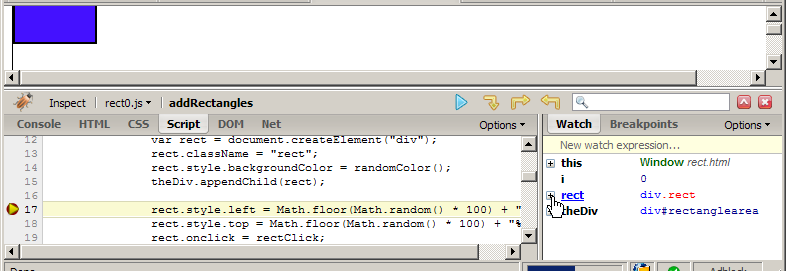
- once stopped at a breakpoint, you can examine variables in the Watch tab at right
- can click + to see properties/methods inside any object
- this variable holds data about current object, or global data
- if the object is global or not listed, type its name in the "New watch expression..." box
Stepping through code

- once stopped at a breakpoint, you can continue execution:
 continue (F8): start program running again
continue (F8): start program running again step over (F10): run current line of code completely, then stop again
step over (F10): run current line of code completely, then stop again step into (F11): run current line of code; if it contains a call to another function, go into it
step into (F11): run current line of code; if it contains a call to another function, go into it step out (Shift-F11): run the current function to completion and return, then stop
step out (Shift-F11): run the current function to completion and return, then stop
Debugging CSS property code
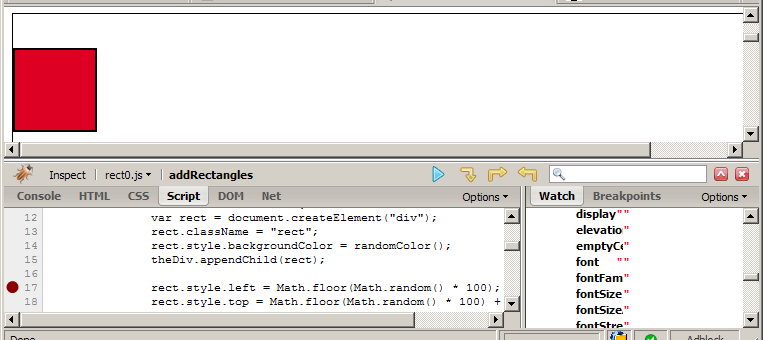
- expand DOM object with +, and expand its
styleproperty to see all styles - also look at HTML (left) tab, Style (right) tab to see styles
General good coding practices
- ALWAYS code with Firebug installed
- incremental development: code a little, test a little
- follow good general coding principles
- remove redundant code
- make each line short and simple
- use lines and variables liberally
- it's good to save parts of a complex computation as variables
- helps see what part of a big expression was bad/undefined/etc.
- blank lines and profuse whitespace make code easier to read
- don't fear the Firebug debugger

